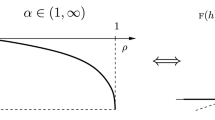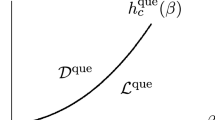Abstract
We study the influence of a correlated disorder on the localization phase transition in the pinning model (Random polymer models, 2007). When correlations are strong enough, an infinite disorder regime arises: large and frequent attractive regions appear in the environment. We present here a pinning model in random binary (\(\{-1,1\}\)-valued) environment. Defining infinite disorder via the requirement that the probability of the occurrence of a large attractive region is sub-exponential in its size, we prove that it coincides with the fact that the critical point is equal to its minimal possible value, namely \(h_c(\beta )=-\beta \). We also stress that in the infinite disorder regime, the phase transition is smoother than in the homogeneous case, whatever the critical exponent of the homogeneous model is: disorder is therefore always relevant. We illustrate these results with the example of an environment based on the sign of a Gaussian correlated sequence, in which we show that the phase transition is of infinite order in presence of infinite disorder. Our results contrast with results known in the literature, in particular in the case of an IID disorder, where the question of the influence of disorder on the critical properties is answered via the so-called Harris criterion, and where a conventional relevance/irrelevance picture holds.

Similar content being viewed by others
References
Alexander, K.S.: The effect of disorder on polymer depinning transitions. Commun. Math. Phys. 279, 117–146 (2008)
Alexander, K.S., Zygouras, N.: The effect of disorder on polymer depinning transitions. Commun. Math. Phys. 291, 659–689 (2009)
Berger, Q.: Comments on the influence of disorder for pinning model in gaussian correlated environment. ALEA 10(2), 953–977 (2013)
Berger, Q., Lacoin, H.: Sharp critical behavior for random pinning model with correlated environment. Stoch. Proc. Appl. 122(4), 1397–1436 (2012)
Berger, Q., Toninelli, F.L.: Hierarchical pinning model in correlated random environment. Ann. Inst. H. Poincaré Probab. Stat. 48(3), 781–816 (2013)
Birkner, M., Greven, A., den Hollander, F.: Quenched large deviation principle for words in a letter sequence. Probab. Theory Relat. Fields 148, 403–456 (2010)
Bolthausen, E., Deuschel, J.-D., Zeitouni, O.: Entropic repulsion of the lattice free field. Commun. Math. Phys. 170(2), 417–443 (1995)
Cheliotis, D., den Hollander, F.: Variational characterization of the critical curve for pinning of random polymers. Ann. Probab. 41, 1767–1805 (2013)
Cornfeld, I.P., Fomin, S.V., Sinai, I.G.: Ergodic Theory. Springer, New York (1982)
den Hollander, F.: Random Polymers, Lecture notes in Mathematics - École d’été de Probabilité de Saint-Flour XXXVII-2007. Springer, Berlin (2009)
Derrida, B., Giacomin, G., Lacoin, H., Toninelli, F.L.: Fractional moment bounds and disorder relevance for pinning models. Commun. Math. Phys. 287, 867–887 (2009)
Doney, R.A.: One-sided local large deviation and renewal theorems in the case of infinite mean. Probab. Theory Relat. Fields 107, 451–465 (1997)
Doney, R.A., Korshunov, D.A.: Local asymptotics for the time of first return to the origin of transient random walk. Stat. Probab. Lett. 81(5), 363–365 (2011)
Fisher, D.S.: Random transverse field Ising spin chains. Phys. Rev. Lett. 69(3), 534–537 (1992)
Fisher, D.S.: Random antiferromagnetic quantum spin chains. Phys. Rev. B 50(6), 3799–3821 (1994)
Fisher, M.E.: Walks, walls, wetting, and melting. J. Stat. Phys. 34, 667–729 (1984)
Giacomin, G.: Random Polymer Models. Imperial College Press, London (2007)
Giacomin, G.: Renewal convergence rates and correlation decay for homogeneous pinning models. Electron. J. Probab. 13, 513–529 (2008)
Giacomin, G.: Disorder and Critical Phenomena Through Basic Probability Models, Lecture notes in Mathematics - École d’été de Probabilité de Saint-Flour XL-2010. Springer, Berlin (2011)
Giacomin, G., Lacoin, H., Toninelli, F.L.: Disorder relevance at marginality and critical point shift. Ann. Inst. H. Poincaré 47, 148–175 (2011)
Giacomin, G., Toninelli, F.L.: Smoothing effect of quenched disorder on polymer depinning transitions. Commun. Math. Phys. 266, 1–16 (2006)
Harris, A.B.: Effect of random defects on the critical behaviour of Ising models. J. Phys. C 7, 1671–1692 (1974)
Igloí, F., Monthus, C.: Strong disorder RG approach of random systems. Phys. Rep. 412, 277–431 (2005)
Lacoin, H.: The martingale approach to disorder irrelevance for pinning models. Elecon. Comm. Probab. 15, 418–427 (2010)
Nadkarni, M.G., Nadkarni, M.G.: Birkhäuser advanced texts. Basic Ergodic Theory. Springer, Berlin (1998)
Piterbarg, V.I.: Gaussian stochastic processes, togi Nauki i Tekhniki. Ser. Teor. Veroyatn. Mat. Stat. Teor. Kibern. 19, 155–199 (1982)
Poisat, J.: Ruelle-perron-frobenius operator approach to the annealed pinning model with gaussian long-range disorder. Mark. Proc. Relat. Fields 19(3), 577–606 (2013)
Shields, P.C.: The ergodic theory of discrete sample paths. Graduate Studies in Mathematics. American Mathematical Society, Providence (1996)
Toninelli, F.L.: Critical properties and finite-size estimates for the depinning transition of directed random polymers. J. Stat. Phys. 26, 1025–1044 (2007)
Toninelli, F.L.: A replica-coupling approach to disordered pinning models. Commun. Math. Phys. 280, 389–401 (2008)
Vojta, T.: Rare region effects at classical, quantum and nonequilibrium phase transitions. J. Phys. A 39, 143–205 (2006)
Weinrib, A., Halperin, B.I.: Critical phenomena in systems with long-range-correlated quenched disorder. Phys. Rev. B 27, 413–427 (1983)
Acknowledgments
We deeply thank F.L. Toninelli for his constant support in this project, and his numerous and precious advices and proof readings, as well as H. Lacoin who was of great help on the manuscript. This work was initiated during the author’s doctorate at the Physics Department of École Normale Supérieure de Lyon, and its hospitality and support is gratefully acknowledged.
Author information
Authors and Affiliations
Corresponding author
Appendices
Appendix 1: On the Sign of Gaussian Sequences
Let \(\mathsf {W}=\{\mathsf {W}_n\}_{n\in \mathbb {N}}\) be a stationary Gaussian process, centered and with unitary variance, and with covariance matrix denoted by \(\Upsilon \), the covariance function being \(\rho _k = \Upsilon _{i,i+k}\). We also denote \(\Upsilon _l\) the covariance matrix of the vector \((\mathsf {W}_1,\ldots ,\mathsf {W}_l)\), which is just a restriction of \(\Upsilon \). We recall Assumption (2.11): correlations are non-negative, and power-law decaying,
Proof Proof of Proposition 3.2
We recall here a more general lower bound, dealing with the probability for a Gaussian vector to be componentwise larger than some given value.
Lemma 5.8
[3, Lemma A.3] Under assumption (2.11) with \(a<1\), there exist two constants \(c,C>0\) such that for every \(l\in \mathbb {N}\), one has
Taking \(A=0\) in this Lemma gives (3.8).
To simplify notations, we prove the upper bound for the specific sequence \(i_k=k\), \(k\in \{1,\ldots ,n\}\). The general proof follows the same reasoning. One first observes that for any subset \(\{k_1,\ldots ,k_m\}\subset \{1,\ldots ,n\}\), \(m\in \mathbb {N}\), one has
The idea is that, if the \(k_j\)’s are sufficiently far one from another, the Gaussian vector \((\mathsf {W}_{k_1},\ldots ,\mathsf {W}_{k_m})\) behaves like an independent one.
Claim 5.9
-
If \( a<1\), then there exists some \(A>0\) such that taking \(k_j:=j\lfloor A n^{1- a}\rfloor \) for \(j\in \{0,\ldots ,m:= \lceil A^{-1} n^{ a} \rceil \}\), one has some constant \(c>0\) such that for all \(n\in {\mathbb N} \)
$$\begin{aligned} {\mathbb P} \left( \mathsf {W}_{k_j}\geqslant 0 \, ;\, \forall j\in \{1,\ldots ,m\}\right) \leqslant e^{-c m}. \end{aligned}$$(6.4) -
If \( a> 1\), then there exists some integer \(A>0\) such that taking \(k_j:=j A\) for \(j\in \{0,\ldots ,m:= \lceil A^{-1}n \rceil \}\), one has some constant \(c>0\) such that for all \(n\in {\mathbb N} \)
$$\begin{aligned} {\mathbb P} \left( \mathsf {W}_{k_j}\geqslant 0 \, ;\, \forall j\in \{1,\ldots ,m\}\right) \leqslant e^{-c m}. \end{aligned}$$(6.5)
This claim, together with (6.3), gives the conclusion. We now prove the claim.
Under \({\mathbb P} \), the vector \((\mathsf {W}_{k_1},\ldots ,\mathsf {W}_{k_m})\) is a Gaussian vector with covariance matrix \(\widetilde{\Upsilon }_m\), with \(\widetilde{\Upsilon }_{ij} = \Upsilon _{k_i,k_j}=\rho _{|k_j-k_i|}\) for \(i,j\in \{1,\ldots ,m\}\). We note \(\widetilde{\mathbb P} \) the law of this \(m\)-dimensional vector. Then if \(\widehat{\mathbb P} \) denotes the law of a \(m\)-dimensional independent standard Gaussian vector \({\mathcal N} (0,\mathrm{Id})\), a change of measure procedure gives thanks to the Cauchy-Schwarz inequality
One has \(\frac{\mathrm{d} \widetilde{\mathbb P} }{\mathrm{d} \widehat{\mathbb P} }(X) = (\det \widetilde{\Upsilon }_m)^{-1/2} e^{-\frac{1}{2} \langle (\widetilde{\Upsilon }_m^{-1}-I)X,X\rangle }\) from the definitions of \(\widetilde{\mathbb P} \) and \(\widehat{\mathbb P} \), so that from a Gaussian computation, one gets
where we defined \(V:=\widetilde{\Upsilon }_m-I\).
We now estimate \(\det (I-V^2)\). Note that the maximal eigenvalue \(\widetilde{\lambda }\) of \(\widetilde{\Upsilon }_m \) verifies
Then we use the definition of \(k_p\) and \(m\), and the assumption (2.11) on \((\rho _k)_{k\geqslant 0}\). We get:
-
if \( a<1\) one has \(\widetilde{\lambda }\leqslant 1+c A^{- a} n^{- a(1- a)} m^{1- a} \leqslant 1+ cA^{-1}\),
-
if \( a>1\) one has \(\widetilde{\lambda }\leqslant 1+c A^{- a}\).
In both cases one chooses \(A\) large enough so that \(\widetilde{\lambda }\leqslant 3/2\). Thus the eigenvalues of \(I-V^{2}\) are bounded from below by \( 1-(\widetilde{\lambda }-1)^2\geqslant 3/4\), so that in the end one has \(\det (I-V^2)\geqslant (3/4)^m\). Combining (6.7) and (6.6) one gets
\(\square \)
Appendix 2: Estimate on the Homogeneous Model
The following Lemma tells that \(n\approx \mathtt {F}(h)^{-1}\) is the threshold at which the partition function starts growing exponentially.
Lemma 5.10
We take \(\alpha \ne 1\). There exist \(\epsilon >0\), and constants \(c, c', c''>0\) not depending on \(\epsilon \), such that if \(0<h\leqslant c'' \epsilon ^{\alpha \wedge 1} \leqslant 1\), then
-
one has \(Z_{n,h}^\mathrm{pur}\leqslant 1+c (n\mathtt {F}(h))^{\alpha \wedge 1} \leqslant 1+c \epsilon ^{\alpha \wedge 1}\) for every \(n\leqslant \epsilon \mathtt {F}(h)^{-1}\);
-
one has \(Z_{n,h}^\mathrm{pur} \leqslant \exp ( c' \epsilon ^{\alpha \wedge 1 -1} \mathtt {F}(h) n)\) for every \(n\geqslant \epsilon \mathtt {F}(h)^{-1}\).
Proof
Because the case \(\alpha >1\) is easier (essentially since \(\mathtt {F}(h)\) is proportional to \(h\)), we restrict to the case \(\alpha <1\).
Using that \({\mathbf P} (|\tau \cap [0,n]|\geqslant k) \leqslant (1-\bar{\mathrm {K}}(n))^k\), one writes
Then, there is some constant \(cst.>0\) such that \(\bar{\mathrm {K}}(n) \geqslant cst. n^{-\alpha } \). Since \(h\in [0,1]\), we have that \(e^h (1- \bar{\mathrm {K}}(n)) \leqslant 1 +2h- cst. n^{-\alpha }\). Since \(\mathtt {F}(h)\) is of order \(h^{1/\alpha }\), we get that, uniformly for \(n\leqslant \epsilon \mathtt {F}(h)^{-1}\), one has \(n^{-\alpha } \geqslant \epsilon ^{-\alpha } h\). Therefore, if \(\epsilon \) is small enough, \(e^h (1- \bar{\mathrm {K}}(n)) \leqslant 1 - \frac{1}{2} cst. n^{-\alpha }<1\). From (7.1) one then gets
which gives \(Z_{n,h}^\mathrm{pur}\leqslant 1+c (n\mathtt {F}(h))^{\alpha \wedge 1}\), since \(\mathtt {F}(h)\) is of order \(h^{1/\alpha }\).
For the second point, one uses that for any two integers \(n_1,n_2\), decomposing over the first return time after \(n_1\), one gets that \(e^hZ_{n_1+n_2,h}^\mathrm{pur} \leqslant e^hZ_{ n_1,h}^\mathrm{pur} e^hZ_{ n_2,h}^\mathrm{pur}\). From this, one gets that for any \(p\in {\mathbb N} \)
where we used the previous bound on \(Z_{n_0,h}^\mathrm{pur} \), the fact that \(h\leqslant c'' \epsilon ^{\alpha }\), and the definition of \(n_0= \epsilon \mathtt {F}(h)^{-1}\). The general bound for \(n\geqslant n_0\) relies on the monotonicity of \(Z_{n,h}^\mathrm{pur}\) in \(n\). \(\square \)
Rights and permissions
About this article
Cite this article
Berger, Q. Pinning Model in Random Correlated Environment: Appearance of an Infinite Disorder Regime. J Stat Phys 155, 544–570 (2014). https://doi.org/10.1007/s10955-014-0965-3
Received:
Accepted:
Published:
Issue Date:
DOI: https://doi.org/10.1007/s10955-014-0965-3
Keywords
- Polymer pinning
- Disordered systems
- Critical phenomena
- Correlation
- Weinrib–Halperin prediction
- Infinite disorder




